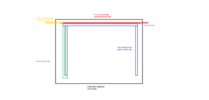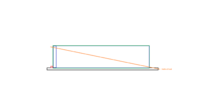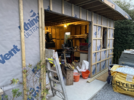About a year ago I started on my garden workshop
I was keen to get going and having little time to focus on exact details (shock of having a 1yo took it toll) I asked a local landscaper to help with the ground works and general landscaping. The site was on a slope and had the only access path (thick concrete) to the property. The scope was basically to excavate the site, prepare ground for new path and lay concrete slab for the workshop.
As there was a slope a retaining wall (approx 700mm high) was required on the rear and the path / slope side required a facing wall to match existing stone. Rather than form separate strip foundations the landscaper laid the slab and the walls were built on top (plans.png)
I remember it wasn't quite what I was expecting at the time but I failed to really appreciate the potential pitfalls this approach has ultimately led to (this post)
I took the decision to build on top of the block walls - standard 4 x 2 pressure treated + 11mm OSB framing as I couldn't see how I could build inside the perimeter / on the slab without water being a serious problem. This build is fairly advanced now, all framing, roof done but it has some problems
1) Visqueen between land drain / limestone and block wall is insufficient - water is penetrating the mortar during heavy downpours. I feel like the only way to solve this is dig out behind the retaining wall and get a liquid DPM / water proofing applied. Problem probably exasperated by the fact that slab protrudes past the wall so there is a nice place for water sit up against and also neighbours garage roof is draining in to the same land drain. Are there any other options or should I just get on with it? If I dig out I will take the neighbours drain past the end of the block wall in solid pipe rather than it connecting it to perforated land drain as that must be adding a lot of work for this land drain.
2) Blockwork is 6 inch and I've built frame in 4 inch pressure treated squared to inside face - this leaves 2 inch overhang outside. I don't think there is much I can do about this one now. I've wrapped the sole plates in plastic, taken the breathable membrane past the wall edge and will be double battening to allow the cladding to sit slightly past the wall. How much water typically gets behind cladding when there is a roof overhang?
3) The front face of the building is sat on the slab someway from the slab edge. Its basically at the point the walls finish in plans.png attached. The roof overhang extends to the slab edge but of course rain doesn't always fall vertically! I see 3 options
a) Do nothing, direct rain should be minimal once cladding is installed, wet slab may get sole plate temporarily wet (has plastic under and lapped up) but pressure treated timber should last some time (hopefully)
b) Acro prop it, cut out bottom, lay brick course, new sole plate
c) Cut the slab flush (or as flush as I can get) with sole plate. Figure out how to deal with the slab around the protruding section of wall (green on plans.png)
Obviously it would have been best to do 3b) or 3c) before I built everything but here I am. I don't know if I should take up the drainage / water penetration issue with the landscaper.
Appreciate any advice given, thanks
I was keen to get going and having little time to focus on exact details (shock of having a 1yo took it toll) I asked a local landscaper to help with the ground works and general landscaping. The site was on a slope and had the only access path (thick concrete) to the property. The scope was basically to excavate the site, prepare ground for new path and lay concrete slab for the workshop.
As there was a slope a retaining wall (approx 700mm high) was required on the rear and the path / slope side required a facing wall to match existing stone. Rather than form separate strip foundations the landscaper laid the slab and the walls were built on top (plans.png)
I remember it wasn't quite what I was expecting at the time but I failed to really appreciate the potential pitfalls this approach has ultimately led to (this post)
I took the decision to build on top of the block walls - standard 4 x 2 pressure treated + 11mm OSB framing as I couldn't see how I could build inside the perimeter / on the slab without water being a serious problem. This build is fairly advanced now, all framing, roof done but it has some problems
1) Visqueen between land drain / limestone and block wall is insufficient - water is penetrating the mortar during heavy downpours. I feel like the only way to solve this is dig out behind the retaining wall and get a liquid DPM / water proofing applied. Problem probably exasperated by the fact that slab protrudes past the wall so there is a nice place for water sit up against and also neighbours garage roof is draining in to the same land drain. Are there any other options or should I just get on with it? If I dig out I will take the neighbours drain past the end of the block wall in solid pipe rather than it connecting it to perforated land drain as that must be adding a lot of work for this land drain.
2) Blockwork is 6 inch and I've built frame in 4 inch pressure treated squared to inside face - this leaves 2 inch overhang outside. I don't think there is much I can do about this one now. I've wrapped the sole plates in plastic, taken the breathable membrane past the wall edge and will be double battening to allow the cladding to sit slightly past the wall. How much water typically gets behind cladding when there is a roof overhang?
3) The front face of the building is sat on the slab someway from the slab edge. Its basically at the point the walls finish in plans.png attached. The roof overhang extends to the slab edge but of course rain doesn't always fall vertically! I see 3 options
a) Do nothing, direct rain should be minimal once cladding is installed, wet slab may get sole plate temporarily wet (has plastic under and lapped up) but pressure treated timber should last some time (hopefully)
b) Acro prop it, cut out bottom, lay brick course, new sole plate
c) Cut the slab flush (or as flush as I can get) with sole plate. Figure out how to deal with the slab around the protruding section of wall (green on plans.png)
Obviously it would have been best to do 3b) or 3c) before I built everything but here I am. I don't know if I should take up the drainage / water penetration issue with the landscaper.
Appreciate any advice given, thanks




